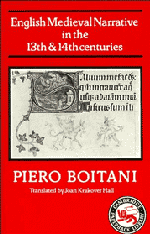1 - The Religious Tradition
Published online by Cambridge University Press: 04 April 2011
Summary
Among the various genres into which we can classify Middle English narrative, religious narrative (that is, the kind of writing that is linked to religion by its subject, its ends, or its background) is not only among the oldest but, in its historical and sociological interest, also one of the richest. It purposely ignores any aesthetic functions or intention; its aims are those proper to ecclesiastical teaching – conversion and edification. Religious narrative was born to fulfil two needs – that of providing good examples to follow and bad ones to avoid, and that of entertaining a public that would not have taken to indoctrination pure and simple. A large number of these narratives were therefore composed to be heard, especially in sermons, and what has come down to us in manuscripts is a formalisation (due to the writing-down of what was spoken) of a kind of narrative that was originally different.
This body of literature was produced almost exclusively by churchmen. Its audience differed according to time and circumstance. Since we are here dealing with works written in English, it is obvious that this kind of literature tended to reach a wider audience as the English language spread upwards throughout the social classes.
- Type
- Chapter
- Information
- Publisher: Cambridge University PressPrint publication year: 1982



